 The demand for rhubarb young plants has risen steadily in recent years. Obviously, the demand for this vegetable plant, which is easy to cultivate and durable, exceeds the supply of conventionally propagated young plants (rhizome parts). We are regularly sold out of rhubarb young plants, so we advise potential customers to inquire about rhubarb young plants for the following spring already this spring or early summer. With this approach, you can not only be sure that you will receive the desired young plants (in a very varied assortment), but also that the potting and production of rhubarb finished products are much easier and can be managed with better results for both the producer and the customer.
The demand for rhubarb young plants has risen steadily in recent years. Obviously, the demand for this vegetable plant, which is easy to cultivate and durable, exceeds the supply of conventionally propagated young plants (rhizome parts). We are regularly sold out of rhubarb young plants, so we advise potential customers to inquire about rhubarb young plants for the following spring already this spring or early summer. With this approach, you can not only be sure that you will receive the desired young plants (in a very varied assortment), but also that the potting and production of rhubarb finished products are much easier and can be managed with better results for both the producer and the customer.
The most important advantage of micropropagated rhubarb young plants: the handling
At Lubera Edibles we do not propagate rhubarb young plants by means of divided rhizomes, as is the case with conventional methods, but by means of micropropagation. This puts us in the fortunate position of being able to offer rhubarb young plants as tray plants. These young plants can be produced, delivered and, above all, processed quite independently of weather conditions. In addition, the potting capacity increases significantly during further processing in the nursery due to the fact that we offer a standardised young plant. Anyone who has ever potted rhubarb rhizomes that have grown free knows what we are talking about...
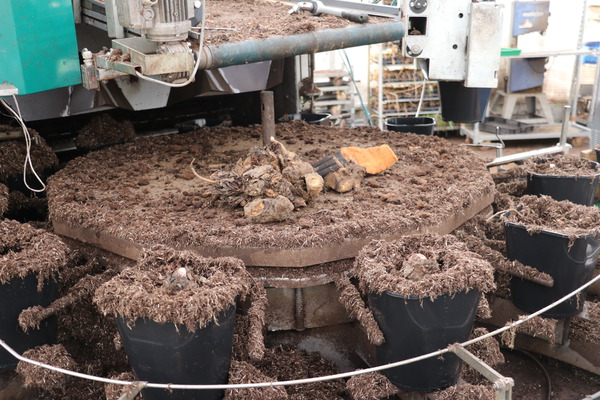
Picture: Rhubarb rhizomes at the potting machine
Further advantages of micropropagated rhubarb young plants
In addition to being easier to process and generally much easier to handle, micropropagated rhubarb young plants have many other advantages...
100% growing results
Depending on the quality of the rhizomes and depending on the season, one has to reckon with sensitive losses when propagating with rhizomes. Our sister company Lubera® has evaluated this in the past and, depending on the potting date, found that 10 to 30% of the plants had not grown. Rhizomes seem to work better with summer potting than winter potting. With micropropagated rhubarb young plants, on the other hand, there are usually no losses; the quality is uniform, meaning that all of the plants grow evenly.
Internal and external plant health
When propagating via rhizomes, a severely damaged piece of the mother plant is replanted. Even if the plant grows, it is not uncommon for new plant parts to develop, but the old root part slowly rots away...this is not a good prerequisite for future plant health and it is hardly noticeable from outside the container. Micropropagated young plants are obtained from virus-tested mother plants cultivated in artificial substrate without disease vectors.
Fresh shoots are used for the initial cultures/establishment. These are taken from the rhizomes together with the leaves/stalks. It is important that the vegetation point is preserved with the meristem. In the next step, these are prepared in the laboratory under sterile conditions, placed on the appropriate growing medium and propagated further.

Picture: Micropropagated rhubarb plants in a culture vessel
The end result is a tiny tray plant (compared to the unmanageable rhizomes), which explodes immediately in the new pot and develops into a fully developed container rhubarb plant at high speed.
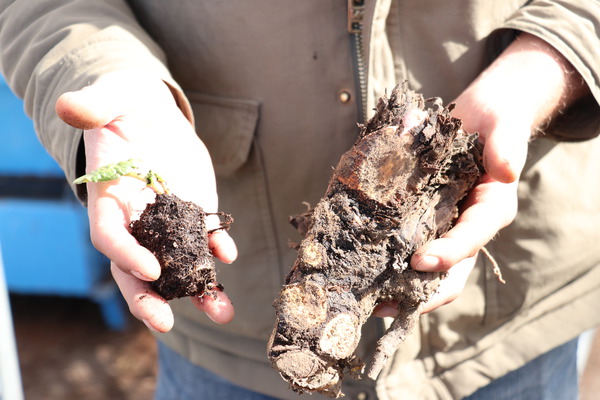
Picture: Hands with a tray plant and rhizome
Flexibility in scheduling
With micropropagated young plants in the two qualities of overwintered young plants and also as green plants, scheduling can be much more flexible than with rhizome pieces delivered on pallets. Once these have arrived, they must be processed as quickly as possible.
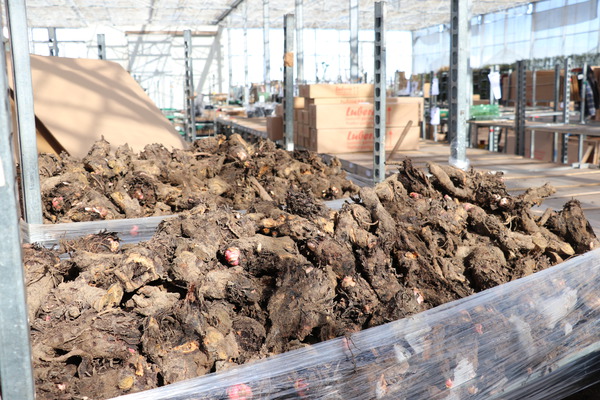
Picture: Rhizome pieces
Extremely fast rooting and saleability
We will go into this further in the growing guide below: micropropagated young plants develop rapidly. They develop a much larger and more finely branched root system than the rhizome plants, which allows them to quickly broaden the crown at the top, develop even more stalks and then form more roots again. The development of a large rhizome is rather secondary for a micropropagated young plant; the rhizome only begins to grow slowly under the crown, in addition one to three thickened (but not yet really thick) storage roots form towards the end of the vegetation period. This means that the micropropagated and potted plant gives priority to the development of the crown and the root system, while the rhizome-propagated plant first grows comfortably out of the reserves before slowly forming fibre roots and new storage roots.
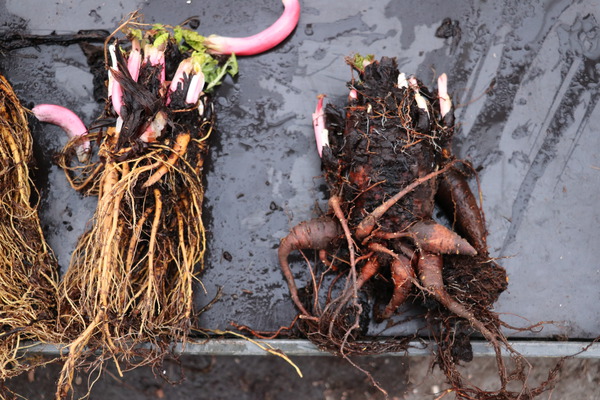
Picture: on the left, a seven month old plant from micropropagated young plants; on the right, a one-year-old plant from rhizome propagation
A wide crown and quickly filled pot
As already mentioned above, it is noticeable with micropropagated young plants that they very quickly develop a broad crown with many secondary buds and also many stalks.
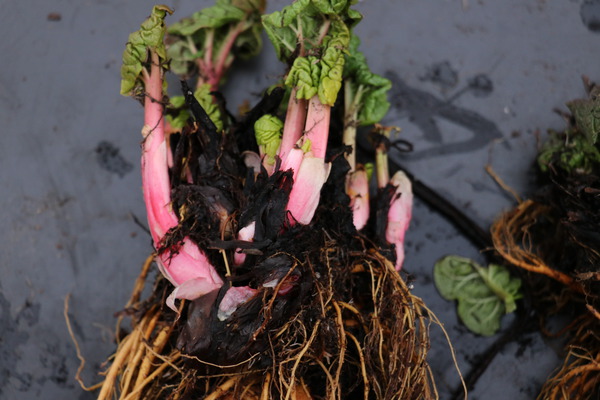
Picture: A wide crown with many buds; potting in July, the picture was taken the following February
Micropropagated rhubarb young plants produce significantly more shoots in the pot than conventionally propagated plants, but on average these remain somewhat smaller and the stalks are also thinner. This is a clear advantage in container production, as the plant “fills” the pot faster and the stalks are less brittle. Planted out in the garden, this normalises after about two years, which means that the stalks get bigger and thicker again.
Different qualities of young plants
We propagate the rhubarb young plants at different times of the year. As with other crops, we offer rhubarb young plants in an overwintered/two year quality as well as in a spring-propagated/one year quality. Both qualities are extremely vigorous and ideally suited for container plant production. Thanks to this double guide of the two young plant qualities, there is even more flexibility for the producer and for his/her planning.
Crop management of the micropropagated rhubarb after potting
The overwintered/two-year-old rhubarb young plants can be delivered at the end of winter in dormant condition. Due to the dormancy of the young plants, they can also be potted directly outdoors. In this way, the plants develop optimally and are ideally adapted to the weather. If potted from March onwards, 3-5 L containers are ready for sale and fully rooted after only 7-10 weeks. With an earlier potting date, the same speed can be achieved (and thus a sales date still in spring) if potting is carried out in a poly greenhouse or plastic tunnel.
The one-year-old/spring-propagated young plants are available starting in the 20th calendar week. These young plants are extremely vigorous and develop very quickly after potting, both in the field/outdoors and in the greenhouse. Here you can expect a ready-to-sell plant even faster after 6-8 weeks. Because these plants are so vigorous and because spring, so to speak, has only begun for them later, it is possible to produce and offer attractive rhubarb plants even in the summer.
If rhubarb plants with beautiful roots are to be produced early for the following spring, we recommend potting in June or July. This is perfectly sufficient to achieve a fully rooted and well overwintered finished plant in a 3-5 L pot. During the winter, we recommend covering the plants with a frost protection fleece.
What you have to pay attention to when managing the crop
As already mentioned, micropropagated young plants differ from rhizomes mainly in that the former initially invest everything in active growth, i.e. they form additional buds, stalks and fibre roots, while the young rhizome plants initially live mainly from the reserves and then slowly form fewer fine roots overall.
This is even more pronounced in everbearing rhubarb varieties, whose root system is even denser and begins to form new fibre roots even faster in the spring than normal rhubarb varieties.
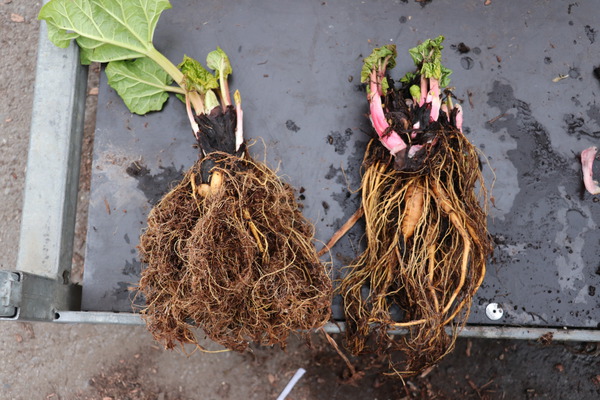
Picture: on the left, the typical root system of an everbearing variety; on the right, a normal variety, both young plants have been micropropagated
The result of all this is that the small young plants develop almost explosively after potting at the appropriate temperature. We have made the experience that even large 5 L pots have to be placed at a distance (chessboard pattern) so that the plants have enough space and do not get crushed or grow unattractively.
Another point is also important when using micropropagated rhubarb young plants: a traditional rhubarb plant that has been potted with a piece of rhizome in the spring or summer essentially sprouts from the reserves, from the rhizome, in the main sales season in the following spring. With a micropropagated plant, this rhizome is not yet so large, but the active and receptive fine root system is much better developed. It must therefore be ensured for a spring delivery that the sales pots are reliably fertilised in the spring and that their portion of slow-release fertiliser has been given, so that the fine roots also have something to absorb...
Advantages at a glance
As has already become apparent, we also attach great importance to the inner quality of our young plants during rhubarb propagation, in addition to the external quality. Furthermore, rhubarb young plants from micropropagation really represent a completely new and much more flexible category of young plants than rhizome pieces. Here are the advantages at a glance:
- Micropropagated young plants are true breeds (genetically identical).
By propagating only a few mother plants, which have been tested in advance for their variety authenticity, we can be sure that the young plants are identical to the starting material.
- Micropropagated young plants are healthy.
All mother plants are tested for relevant viruses/diseases before each new propagation cycle, which also gives us an overview of the phytosanitary status of the young plants. In addition, micropropagated young plants are holistically intact compared to rhizomes. By definition, rhizomes have been injured and divided…
- Micropropagated rhubarb young plants are extremely vigorous.
Rhubarb is generally already very vigorous, but the plant material is deliberately kept juvenile during micropropagation and this also has an effect on the young plants, which develop much faster than rhizomes after potting. Above all, they develop more roots and stalks/buds more quickly.
- Micropropagated rhubarb young plants are uniform.
Due to the micropropagation and cultivation of the young plants in trays, our young plants are very even and uniform, which also has a positive effect on the subsequent container/pot plant production.
- Micropropagated young plants are easy to process.
In contrast to rhizomes that have grown rather unevenly, the very uniform tray plants are much easier to pot and can even be processed mechanically.
Click here for more information.
Would you like more information, an individual consultation or information about additional ranges?
Click here for the complete 2019 catalogue, which can be downloaded.
If you have specific questions, please do not hesitate to contact our customer service, where you can also spontaneously place an order.
And of course we are always there for you via telephone.
If you want to be regularly informed about news, etc., you can also subscribe to our gardener newsletter here, which we send out about once a month - it's worth it!
